The Angelbird Wings PX1 M.2 Adapter Review: Do M.2 SSDs Need Heatsinks?
by Billy Tallis on December 21, 2015 8:00 AM ESTMixed Random Access
Instead of testing a range of queue depths, our mixed workload tests vary the proportion of reads and writes while using a constant queue depth. The test begins with pure reads, then incrementally shifts toward pure writes with three minutes for each subtest. As more writes come in to the mix, the odds increase that a read request will be held up by one of the flash chips being busy with a longer-duration write. Likewise, having lots of reads in the mix can limit the drive's ability to combine writes into larger batches. Thus, the worst performance on these tests usually occurs somewhere around the middle. To approximate client workloads, the mixed random access test uses a queue depth of three and like the random write test it is restricted to a 16GB portion of the drive.
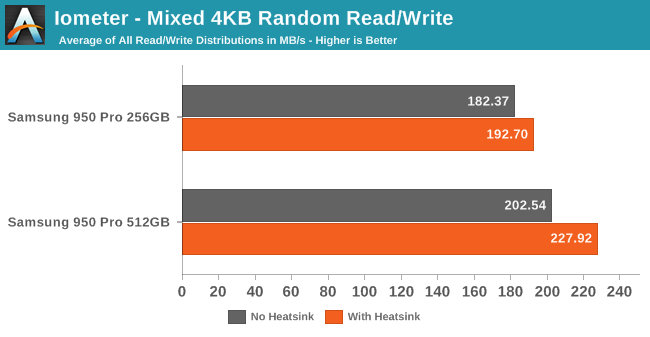
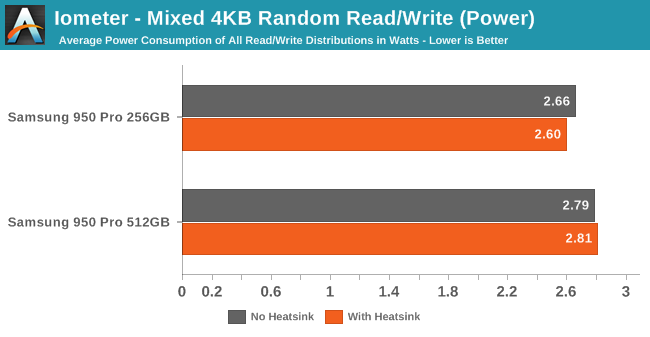
The mixed workloads were the only tests where the two capacities showed significant performance differences even without the heatsink, indicating that thermal throttling was much less of an issue for the 950 Pro here. The heatsink still helps, but only slightly. Given how random reads were essentially unaffected by the heatsink, it's a bit of a surprise that the writes improved by enough to bring the average up by 12.5% for the 512GB drive.
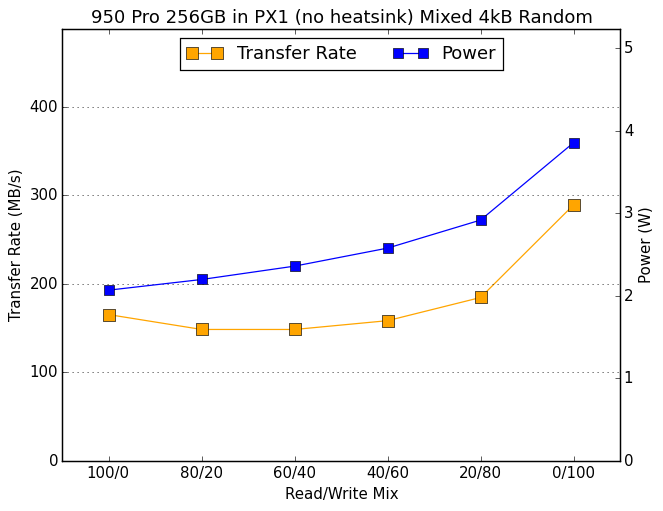 |
|||||||||
| 256GB no heatsink | 512GB no heatsink | ||||||||
| 256GB with heatsink | 512GB with heatsink | ||||||||
Almost all of the performance improvement with the heatsink comes at the very end of the test as it shifts to pure writes. Performance earlier in the test is virtually unaffected by the heatsink, but power efficiency does see the slight improvement from lower operating temperature.
Mixed Sequential Access
As compared with the mixed random test described above, the mixed sequential test differs by using a queue depth of one and by requesting larger chunks of data. This test operates across the whole drive, which is pre-filled with data.
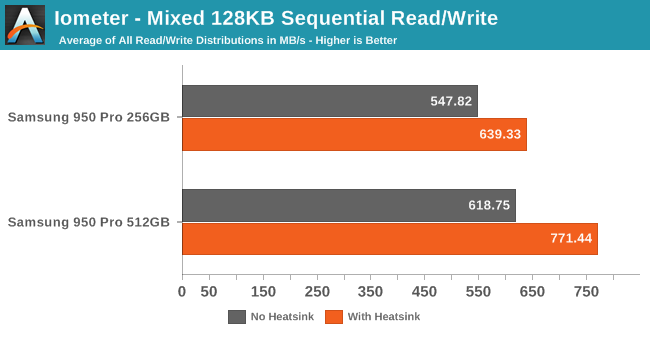
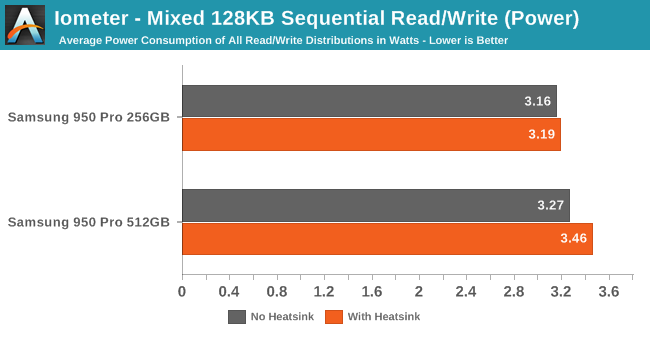
Both of the previous sequential performance tests showed huge improvements even at low queue depths, so it's no surprise to see a significant improvement in a mix of the two.
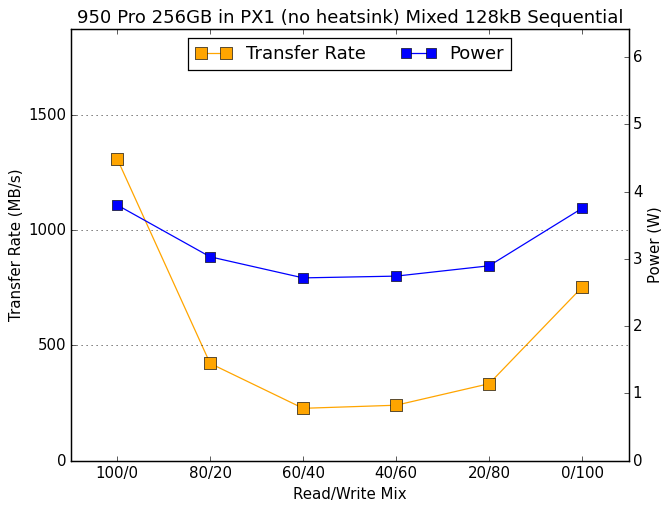 |
|||||||||
| 256GB no heatsink | 512GB no heatsink | ||||||||
| 256GB with heatsink | 512GB with heatsink | ||||||||
A closer look reveals that the overall performance improvements are once again attributable to the non-mixed segments of the test. Unlike the mixed random test, read speeds are part of the improvement here. But on the sub-tests with a balanced mix of reads and writes, the 950 Pro wasn't throttling even without the heatsink.










69 Comments
View All Comments
RealBeast - Monday, December 28, 2015 - link
"You know, since the LED's are white" Not really.Tell the Nobel committee about it. The 2014 prize in physics went to the blue boys -- red and green had been around for a while, and only they made white possible: http://www.nobelprize.org/nobel_prizes/physics/lau...
h4rm0ny - Tuesday, December 22, 2015 - link
Whilst agreeing with your point, you want either 'irrespective' or 'regardless', not "irregardless".More on topic I agree with both of you - I both recognize that what Teizo says about the customer base is probably true, and also agree with mooninite's despair that this is so. The two posts are not incompatible.
Murloc - Tuesday, December 22, 2015 - link
-less = withoutir- = in- before an 'r', the same as English un- (in- is latin, un- is germanic), it has a negative or privative force.
pick one but not both.
That said, RGB LEDs would make it cost too much, the price is already too high for consumers.
ddriver - Monday, December 21, 2015 - link
DO'H, it is not rocket science, if it overheads and throttles back as a result, then it obviously needs a heat sink.bug77 - Monday, December 21, 2015 - link
I think these tests answer another important question: when does it overheat.As it is, the drives only overheat during sustained write. This is far from unexpected, but at the same time it is reassuring to know it is the only scenario where a drive would throttle (as opposed to throttling under regular desktop usage).
ddriver - Monday, December 21, 2015 - link
But what about another important question, how much does it "hurt" to add a dollar worth of aluminum to improve a product worth several hundred dollars?bug77 - Monday, December 21, 2015 - link
If you have ever installed an M.2 drive, then you know there's not much space left for a heatsink. And you can only install it on one side. Even so, it's so close to the motherboard (and usually between PCIe slots) that if you don't have a hell of an airflow, it won't make much difference anyway.And that's only for desktops, good luck trying to fit a M.2 drive with a heatsink attached into an ultrabook.
ddriver - Monday, December 21, 2015 - link
You are very limited conceptually - it doesn't have to be a "radiator" type of heatsink, a flat piece of aluminum 2-3 mm thick would suffice. Heatsinks come in various shapes and sizes, not necessary the bulky, thick finned design.The SSD doesn't displace a lot of heat to begin with, but without a heatsink for that HEAT to SINK into the bare chip quickly runs out of thermal room.
Even if it still throttles, it will ramp the temp up slower as the heatsink will act as a buffer, and regardless of how little airflow it may have, a larger piece of aluminum will always displace much more heat than a tiny chip.
It will be slower to overheat and faster to cool, even in an ultrabook or tablet, and yes, with the kind of heatsink it merits it will have no trouble fitting into portable devices.
Judging by the performance regressions from adding a heatsink to the larger model, it would seem that engineers were well aware it throttles and have optimized the product for it, so taking care of the heat puts the device in a less than optimal standing. A firmware update should be enough to address this issue and eliminate any sort of performance regressions and actually improve it somewhat. Engineering a product which runs worse with better cooling - that's kind of an epic fail.
jjj - Monday, December 21, 2015 - link
Unless it detects benchmarks and lets the controller clock higher for better scores.If VW can do it , the possibility needs to be investigated elsewhere too.nathanddrews - Monday, December 21, 2015 - link
You know what this means, right? Next test: custom water blocks.